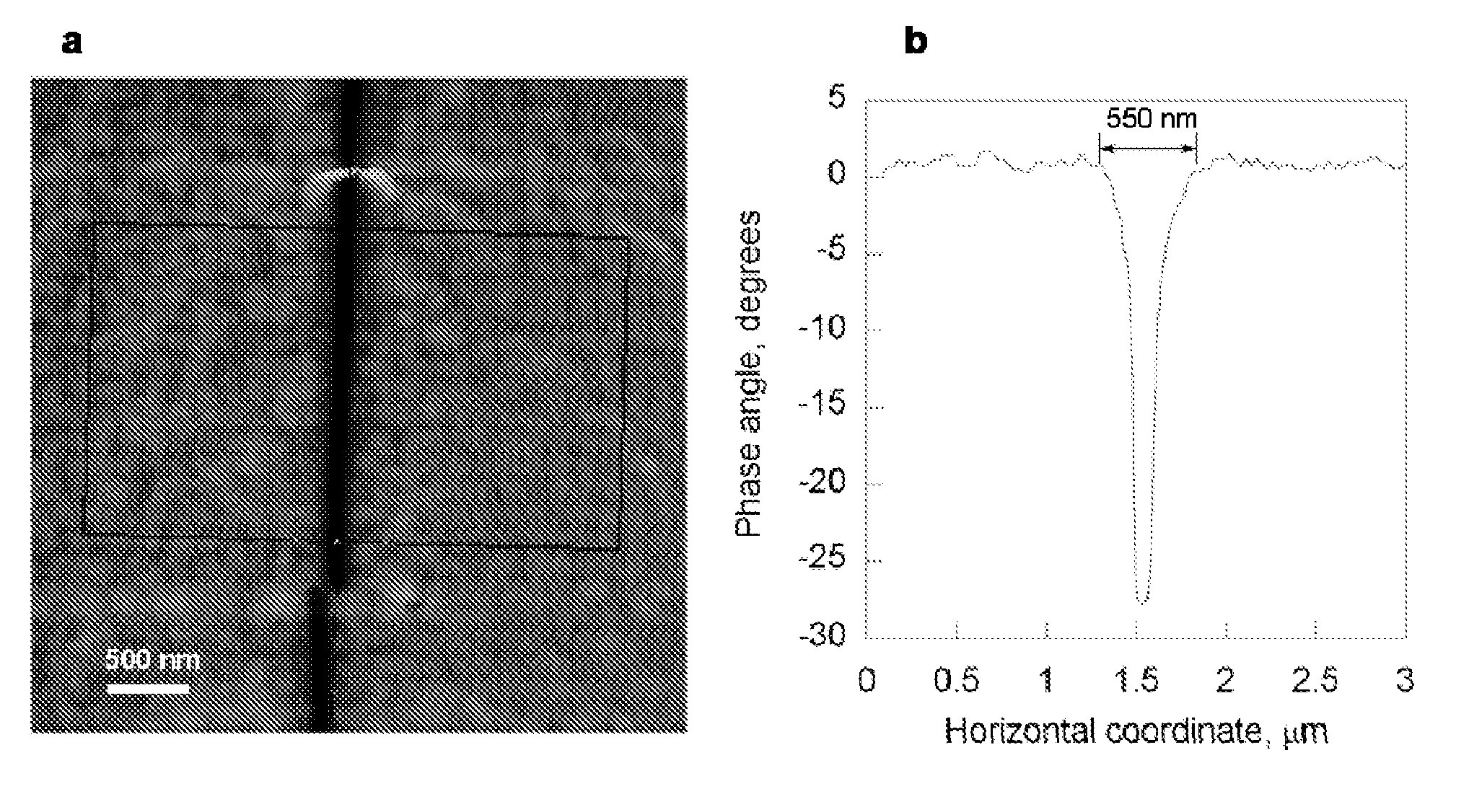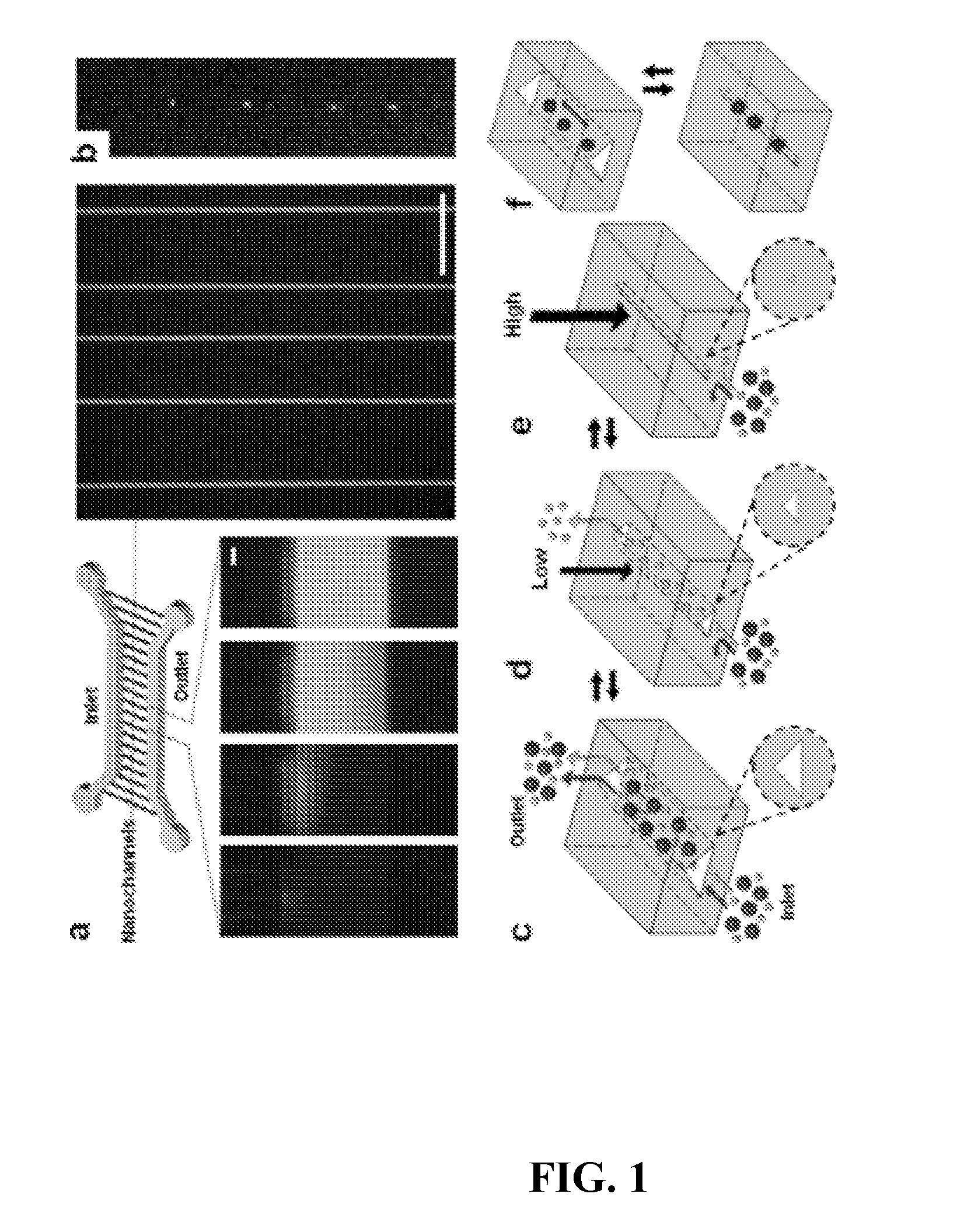Tunable elastomeric nanochannels for nanofluidic manipulation
- Summary
- Abstract
- Description
- Claims
- Application Information
AI Technical Summary
Benefits of technology
Problems solved by technology
Method used
Image
Examples
example 1
Methods
[0101]Generation of nanocrack patterns: PDMS (Sylgard 184, Dow Corning) base and curing agent were mixed at a weight ratio of 10:1. Degassed PDMS prepolymer was cast against a photolithographically-prepared SU8 (SU8-50, MicroChem Corp.) mold and cured at 60° C. for 4 hours to produce PDMS substrates with recessed inlet and outlet microchannel features. The substrates were then cleaned with adhesive tape and treated with oxygen plasma for 4 minutes in a bench-top plasma etcher (Plasma Prep II, SPI Supplies). Vacuum pressure and operation current used for plasma treatment were 150 mTorr and 30 mA, respectively. Subsequently, the oxidized PDMS surface was stretched to a strain of 5˜10% for 10 seconds by an electronically controlled stretcher (ST140, STREX Inc.) to create nanocracks.
[0102]Fabrication of nanochannel molds: The PDMS surface with nanocracks was silanized with (tridecafluoro-1,1,2,2-tetrahydrooctyl)-1-trichlorosilane for 1.5 hours in a vacuum desiccator. Nanochannel ...
example 2
Nano-Cracking of the Surface-Modified Layer of Poly(Dimethylsiloxane) Created by Exposure to Plasma Oxygen
[0112]This example describes an investigation of the material properties of plasma-oxidized PDMS. The properties of the PDMS are straightforward to determine with established experimental methods, and are presented in Section 2. Addressing the challenge of assessing the material properties of the surface-modified layer, Section 3 demonstrates a two-step method, using the AFM, to determine its thickness and elastic modulus. Finally, in Section 4 the fracture behavior of a surface-modified layer is discussed in the light of the measured material properties.
[0113]2 Materials Preparation and Properties of the Bulk PDMS
[0114]2.1 Materials Preparation
[0115]Initial studies showed that both the ratio of the polymer to the curing agent, and the curing schedule affected the constitutive behavior of the resulting elastomer. Therefore, care was taken to ensure that all experiments were perf...
example 3
Dynamic Modulation of Focal Adhesion Complexes in Response to Strain and Compression of Protein-Matrices
[0158]This example describes the growth of cells on protein coated cracks. FIG. 36 shows a schematic Illustration of cracking protocol layered system with PDMS substrate (thickness=3.5 mm)+Cr intermediate layer (10 nm thickness)+Au layer (40 nm thick) fastened to silanized glass slide with a thin layer of spin-coated PDMS through the sputtering / evaporation process to minimize external stresses. The system is removed from the glass slide by ethanol coating and fastened into stretching device. The entire surface of the system is coated with self-assembled monolayers (SAMs) of alkanethiolates with a terminally substituted oligo(ethylene glycol) group to make the Au surface non-fouling Strain is applied, the thin surface layers crack into the PDMS layer, revealing new PDMS substrate. The entire system is then coated with laminin / fibronectin—however, the adhesion protein selectively ad...
PUM
| Property | Measurement | Unit |
|---|---|---|
| Biological properties | aaaaa | aaaaa |
| Transport properties | aaaaa | aaaaa |
| Strain point | aaaaa | aaaaa |
Abstract
Description
Claims
Application Information
 Login to View More
Login to View More - R&D
- Intellectual Property
- Life Sciences
- Materials
- Tech Scout
- Unparalleled Data Quality
- Higher Quality Content
- 60% Fewer Hallucinations
Browse by: Latest US Patents, China's latest patents, Technical Efficacy Thesaurus, Application Domain, Technology Topic, Popular Technical Reports.
© 2025 PatSnap. All rights reserved.Legal|Privacy policy|Modern Slavery Act Transparency Statement|Sitemap|About US| Contact US: help@patsnap.com



